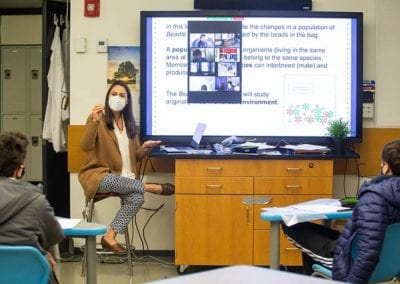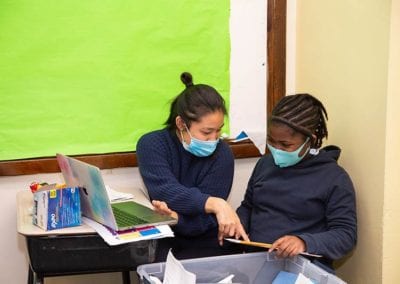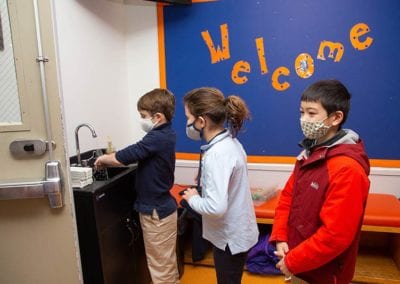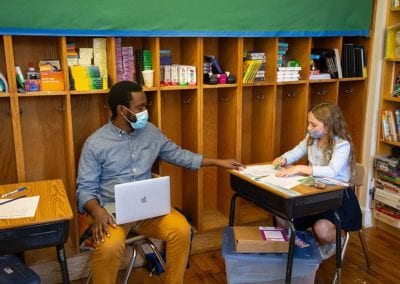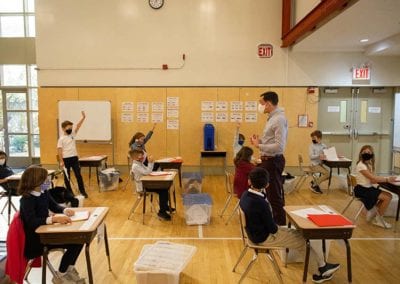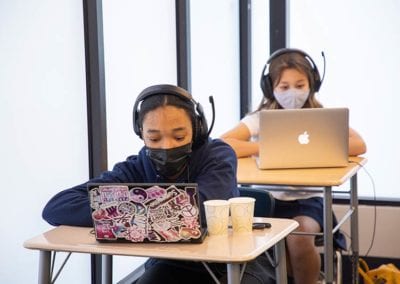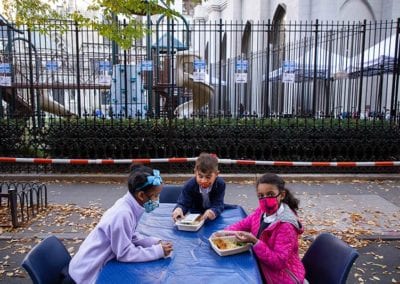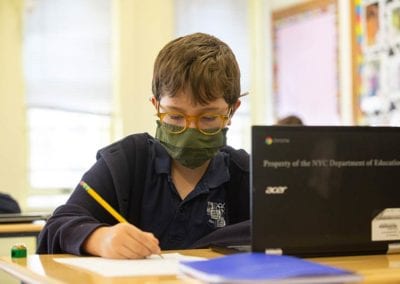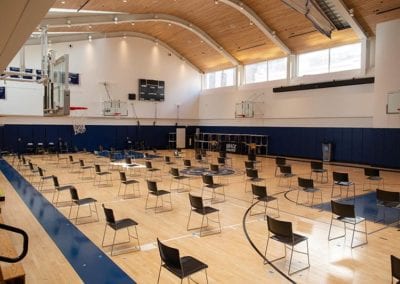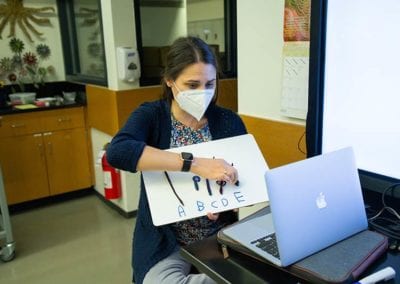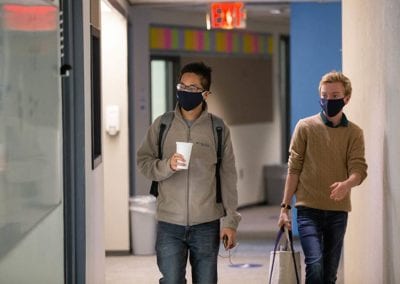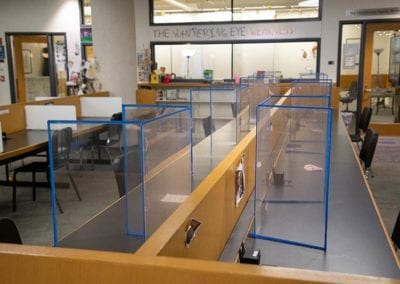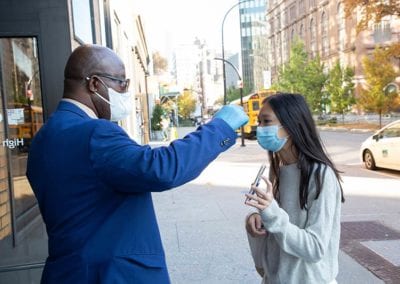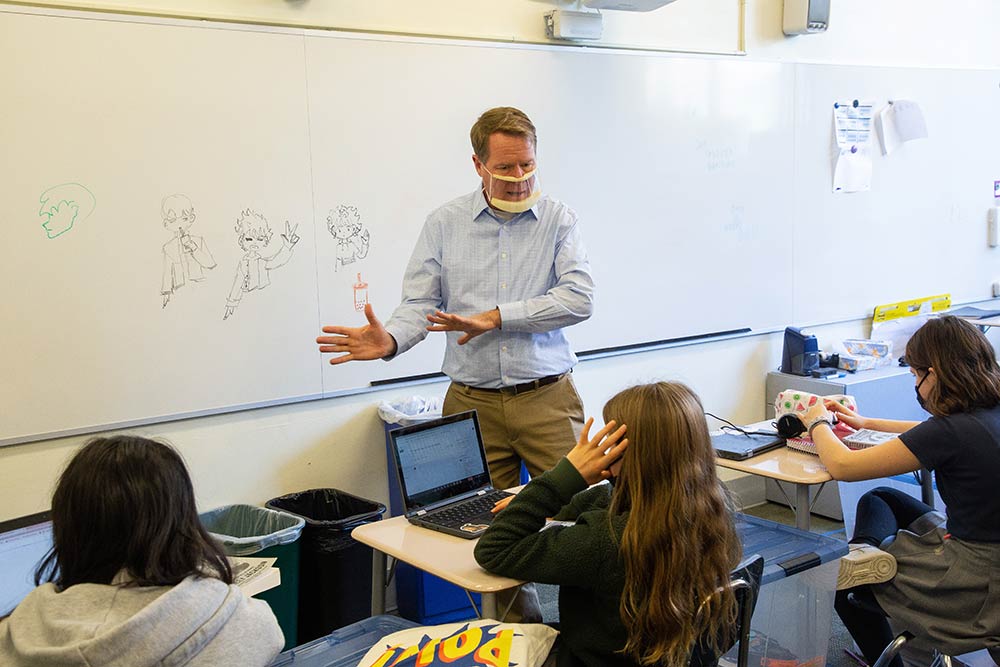Open Grace
Overcoming the Obstacles to Successfully Reopen Campus
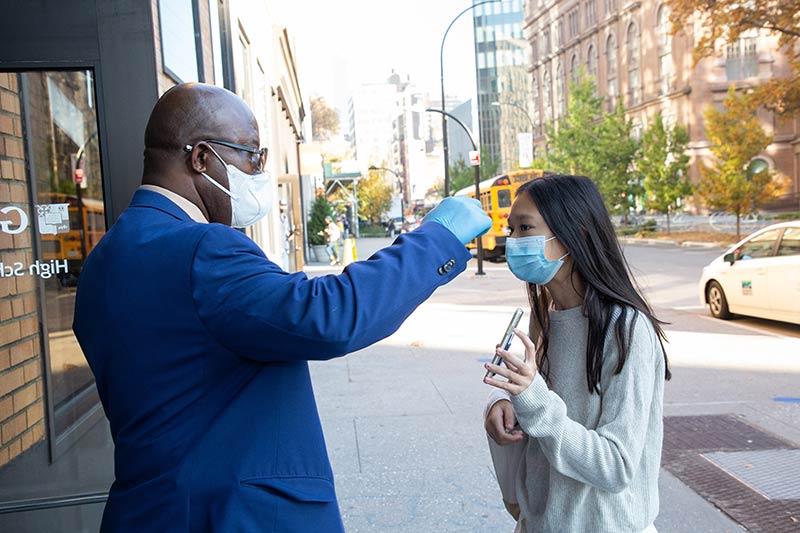
Grace’s success in navigating this school year, holding in-person school for 23 weeks as of March 1, is no small feat. Beginning during the shutdown last spring and continuing through the summer, our faculty, staff, and administration worked tirelessly to integrate the latest known scientific information about COVID-safety with best educational practices. The most crucial moment in Grace’s pandemic response, explains Assistant Head of School Robbie Pennoyer, was clarifying the shared values that would guide subsequent decisions. “We made a commitment that we were going to take good care of one another,” Mr. Pennoyer says. “That principle has inspired a strong response within our community.”
Delivering on this goal meant offering students and faculty the option to remain fully remote, while also reopening campus. It also meant a full review of school operations, with eight distinct committees examining different aspects of the experience. By the time school began in September, space had been reallocated, academic schedules and calendars were adjusted, air filtration was increased, and testing procedures were in place. Whereas Grace had previously provided each student with a personal computing device beginning in Grade 7, iPads or Chromebooks were issued for students as young as Grade 2. Arrows now direct traffic through school hallways, portable sinks encourage frequent hand-washing, and windows remain open during class. “Despite the ongoing challenges, every day we find pockets of joy that sustain us,” Mr. Pennoyer says. “We are getting through this experience in a way that feels consistent with who Grace is as a community.”
To serve the developmental needs of students in JK through Grade 4, Grace prioritized making school available on campus every day for our Early Childhood and Lower School divisions. Instead of the typical three classrooms, this year grades are divided into four classes. Every available space—including Tuttle Hall, the library, and half of the dining room—has been converted into a classroom where students can learn while maintaining distances of six feet. During the fall, students also had a practice remote day, so they gained confidence in using devices for virtual learning as needed. Knowing that young children may feel separation anxiety—particularly after being in close quarters with their families for so long—our faculty turned up the fun to greet students with music and a sense of playfulness at morning drop-off. “The children were brave and it went enormously well, which set the tone going forward,” says Cheryl Kelly, Head of Early Childhood. “The children were truly excited to meet new teachers and friends.”
In the Middle School, students were divided into two cohorts that rotate between having one day on-campus and one day of remote learning. Grace also leased and outfitted the former Chase Bank at the corner of 10th Street and Broadway to be a space where middle schoolers can attend their remote classes. “The Broadway” has become very popular because it offers students a community-based setting, along with breakout rooms where they can participate in music and dance classes. The faculty who facilitate this space are dance and theater focused, and have developed creative ways for students to release energy and have fun, while staying safe and focused during remote learning. Securing a permit from the city to close 10th Street between Broadway and 4th Avenue has been another strategy to expand student options. In good weather, students regularly have recess, lunch, gym class, and other activities outside. Periodically, the Middle School Division hosts a community day in which all of a grade will be on campus, so that students can build shared experiences as a full class.
“Middle schoolers are often trying to define who they are,” says Elsa Hepner, Head of Middle School. “Part of that process is separating from their families, which is incredibly difficult during a pandemic. By creating these times and spaces, Grace is offering students another way to have the time together that they crave.”
High school students also have been divided into A and B cohorts that rotate between having two days on and two days off campus. Grace’s block schedule usually offers a cycle of 80-minute blocks for core academic classes, with Wednesdays being reserved for lab classes. This year features 60-minute classes, and the curriculum of lab days have been consolidated to create five intersession weeks around the themes relating to social justice, wellness, and sustainability. As a silver lining to this year’s schedule, students do not need to rise early for the chapel and community meetings that in the past were at 8 a.m. on Thursdays but have currently moved to mid-morning on Wednesdays. In addition, faculty are adjusting lesson plans as needed to maximize student engagement. “We’ve always been a high school that seeks balance,” Mr. Mahabir says. “Without balance, you can reach a point of diminishing returns—for health, well-being and learning.”
Meanwhile, deans, advisors, and counselors are paying especially close attention to students’ individual needs. Our guidance and support systems are robust, with counselors offering drop-in hours, as well as scheduled times for students to talk. “As young adults, high school students are fully aware of what is happening around them,” says Hugo Mahabir, Head of High School.
While this year’s schedule is unusual, Grace students and parents have expressed appreciation of its continuity. “Our families have really kept faith with the school and believe in what we are doing,” Mr. Mahabir says. “They see that students are engaged and growing. In spite of all these obstacles, there is substance.”
“We were enormously touched by the number of families—with students of any age—who chose to come on campus this year,” adds Mrs. Kelly. “That shows the incredible trust parents have in choosing Grace as a school for their children.”
We would like to express our gratitude to the members of the Grace community who donated PPE, hand sanitizer, and other resources that aided in the reopening of our campuses.
Reopening Image Gallery
Reopening Videos
Hand sanitizers
The Broadway classroom
The Broadway book room
Innovation in the Classroom
For many faculty, teaching during the pandemic has felt like being a brand-new teacher all over again. Last summer all Grace faculty engaged in professional development to hone in on a cohesive set of tools for remote learning. Simultaneously, the reopening of campus with new schedules and physical distancing requirements required faculty to revisit lesson plans and re-envision how collaboration occurs in the classroom. In addition, smaller class groupings mean that some of our Middle and High school faculty are teaching more class sections than ever. And in some cases—because either a student or a faculty member is remote—teachers must develop an effective rapport with students without ever being in the same room together. Within this context, our faculty and students are discovering this to be a school year that is defined by resilience and ingenuity.
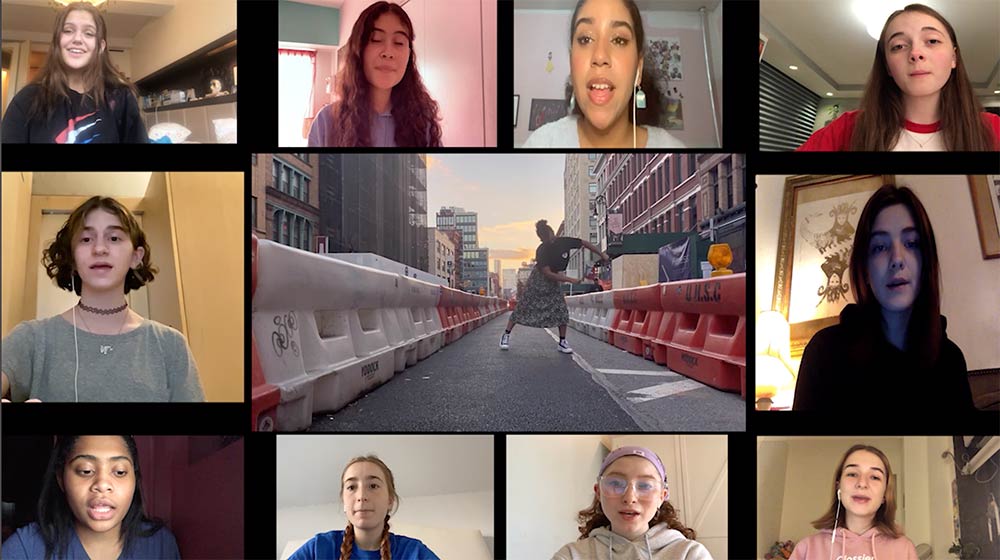 Even though most students convene on campus daily, the Early Childhood and Lower School divisions are finding that technology is opening doors to new possibilities. When first graders studied the continents, the accessibility of video conferencing made it easier to interview families who come from other countries. Video conferencing has also made it easier to bring special guests into the classroom and for parents to attend teacher conferences. One unique aspect of Grace is even going viral in its own modest way. “Chapel has always captured the essence of a Grace education because it focuses on stories about kindness, love, and respect,” says Cheryl Kelly, Head of Early Childhood. “Now that these sessions are virtual, they have become a family event at home. We are hearing from parents that some children are watching the Chapel videos over and over and are sharing them with grandparents and other family members.”
Even though most students convene on campus daily, the Early Childhood and Lower School divisions are finding that technology is opening doors to new possibilities. When first graders studied the continents, the accessibility of video conferencing made it easier to interview families who come from other countries. Video conferencing has also made it easier to bring special guests into the classroom and for parents to attend teacher conferences. One unique aspect of Grace is even going viral in its own modest way. “Chapel has always captured the essence of a Grace education because it focuses on stories about kindness, love, and respect,” says Cheryl Kelly, Head of Early Childhood. “Now that these sessions are virtual, they have become a family event at home. We are hearing from parents that some children are watching the Chapel videos over and over and are sharing them with grandparents and other family members.”
Sometimes faculty are finding silver linings as they develop new teaching methodologies. Middle School teachers, for example, took advantage of students being at home during hybrid learning to have lessons on making crepes in French class and Día de Los Muertos cakes in Spanish class. Middle School math teachers converted a project about exponential growth and decay from a paper printout to Google Slides. They discovered that going digital enhanced the project because students could easily integrate a web-based program for graphing, plus apply graphic design skills to their presentations. In addition, students were inspired by current events to apply their learning to calculate the spread of the COVID virus, the production of vaccines, and declining sales of small businesses.
“The way that students have adapted this year is amazing,” says Elsa Hepner, Head of Middle School. “This style of schooling requires a lot of executive functioning and organizational skills. Yet the students are learning real-world skills and taking every difficulty that comes their way in stride.”
Head of High School Hugo Mahabir observes the same to be true among students in grades 9-12. “Our students are learning to be more resourceful and better self-advocates,” he says. “Because they can’t rely on seeing someone tomorrow, they are becoming more self-directed in a positive way.”
This year’s schedule brought a unique opportunity to expand the annual MLK Symposium from a single day to spanning the course of a week. This meant developing a broader array of faculty- and student-led sessions that built on the antiracism work that has been emphasized this school year. In day-to-day classes, High School faculty have been adjusting the scope and sequence of their classes, focusing on what is most essential. “The constant amidst this change is that our students are receiving as rich an academic program as they always have had,” Mr. Mahabir says.
In every division, Grace’s arts faculty have played a key role in cultivating a sense of community and imagination during this time. Visual arts faculty have sent supplies home to ensure that remote students can create, and performing arts faculty have thought outside the box to adapt. The first performance for Grade 5 instrumentalists involved students making individual recordings, which faculty knit together to create the effect of an ensemble. Meanwhile, the GraceNotes choral ensemble focus on non-singing activities while in-person and use asynchronous learning times to practice singing.
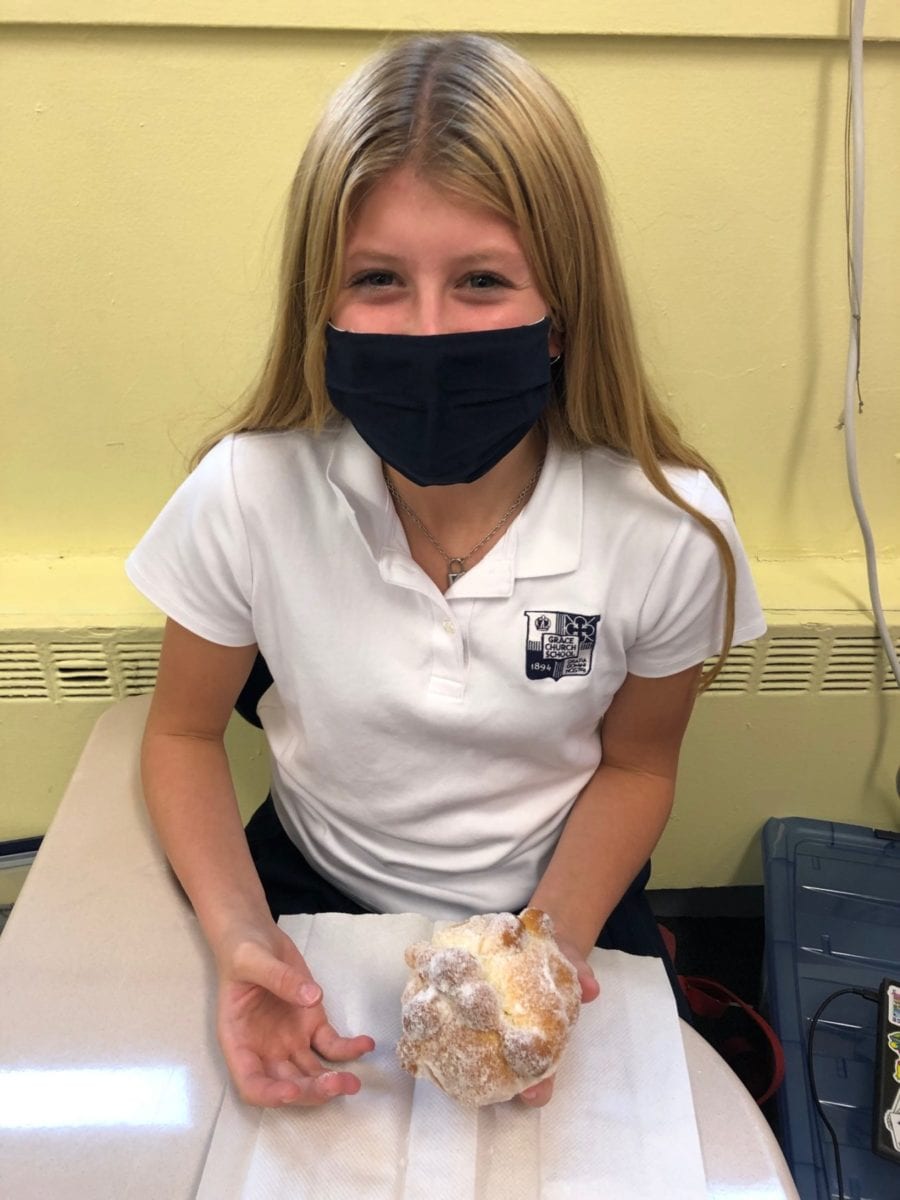 Beginning in the fall, English and theater faculty invited Middle School students to keep journals about living in this historical moment. The students wrote about the pandemic, hybrid school, quarantine, the Black Lives Matter movement, the presidential election, and the general political climate. This work evolved into a devised theater piece, which is a collective creation centered around a common purpose. The journals became the foundation of a theatrical work that was rehearsed, written, and filmed entirely online. The resulting multimedia production, called “Flash Forward, Flash Back: Good-bye 2020” was completed in January. The High School production of “We Wear the Mask,” was presented as a Zoom performance in December. An original work by a Grace faculty member, this play explores the ways in which physical and metaphorical masks can help people survive dangerous situations and how taking off the symbolic mask requires trust. To experiment further with the medium, ticketholders received emails that allowed them to engage with the characters even before the performance began.
Beginning in the fall, English and theater faculty invited Middle School students to keep journals about living in this historical moment. The students wrote about the pandemic, hybrid school, quarantine, the Black Lives Matter movement, the presidential election, and the general political climate. This work evolved into a devised theater piece, which is a collective creation centered around a common purpose. The journals became the foundation of a theatrical work that was rehearsed, written, and filmed entirely online. The resulting multimedia production, called “Flash Forward, Flash Back: Good-bye 2020” was completed in January. The High School production of “We Wear the Mask,” was presented as a Zoom performance in December. An original work by a Grace faculty member, this play explores the ways in which physical and metaphorical masks can help people survive dangerous situations and how taking off the symbolic mask requires trust. To experiment further with the medium, ticketholders received emails that allowed them to engage with the characters even before the performance began.
Across every grade level, and in every subject, says Assistant Head of School Robbie Pennoyer, “This year has been an extraordinary testament to the creativity of our faculty and students.” You can explore more of what has happened on campus on our Excellence in Distance Learning page and the Teaching & Learning Blog.

Family Security Fund
In March 2020, at the suggestion of many Grace families looking to help those in the Grace community affected by the Covid-19 pandemic, the school established the Family Security Fund to be available to any family faced with hardship because of lost employment or compensation stemming from this crisis. The fund, administered by the Director of Financial Aid, Sarah Adler, has been used for expenses including groceries, housing, medical expenses, or access to technology for remote learning.
Parents, alumni, grandparents and friends of Grace sprung into action—as of January 2021, the fund has received contributions from more than 200 donors, with support pouring in from every corner of our community. 57 Grace families have benefited from the Family Security Fund. For more information, contact Courtney Archer-Buckmire, Director of Advancement.

The 35th Annual Auction Benefit
For the Endowment for Financial Aid
THE MAGIC OF GRACE
THURSDAY, MARCH 11, 2021
7:00 PM
ONLINE
Silent auction bidding opens on March 9 and ends during the event.
Live auction will be online.
Each spring, the Parents’ Association annual Auction Benefit provides funds to support the Endowment for Financial Aid, allowing Grace to remain accessible to families regardless of their socio-economic status. Last year, ticket sales and underwriting donations alone raised over $240,000 for financial aid. Your support helps ensure the vitality of the Grace community into the future.
Alumni Personal History in the Classroom
Jason McDonald, History
“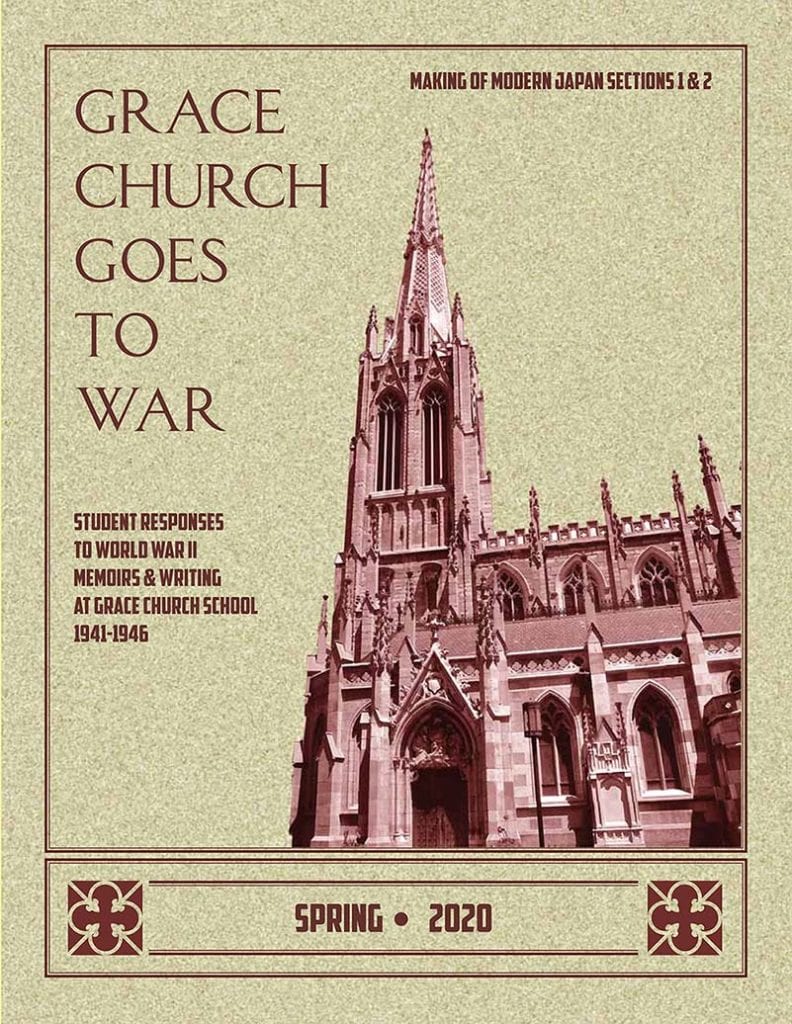 In the spring of 2019, I met Hale Bradt ’45 while he was visiting the school. I was introduced to his three volume book, Wilber’s War, which chronicles his family’s story through letters between his parents during his father’s deployment in the Pacific War. Mr. Bradt brilliantly encapsulated a complicated and moving story of romance, personal combat, family ties and deep loss set against the sprawling chaos of the liberation of the Philippines.
In the spring of 2019, I met Hale Bradt ’45 while he was visiting the school. I was introduced to his three volume book, Wilber’s War, which chronicles his family’s story through letters between his parents during his father’s deployment in the Pacific War. Mr. Bradt brilliantly encapsulated a complicated and moving story of romance, personal combat, family ties and deep loss set against the sprawling chaos of the liberation of the Philippines.
I thought about my 11/12 elective, The Making of Modern Japan, and how Mr. Bradt’s book might be a resource for the class. The course focuses on the Pacific War, beginning with the civil wars in 17th century Japan, and everything related to Japan’s imperialist expansion in Asia leading up to the use of the atomic weapons on Hiroshima and Nagasaki. Students work with both primary sources like participant diaries and oral histories as well as the work of noted historians.
Mr. Bradt adapted Wilber’s War into a single volume book and a multi-media staged reading. Over the coming months, we began to explore how we could use these in the classroom. I decided to use Wilber’s War as a source text in class, which Mr. Bradt generously provided for the students. We also tapped the Alumni Office for additional primary sources: a trove of writing by students and alumni during World War II is preserved in The Quarterly, a student publication of the time.
Students used their favorite pieces from the book and The Quarterly as launching points for their projects. They researched the events discussed in the readings, and then wrote an emotional reaction to the work. We planned a student-created staged reading inspired by Mr. Bradt’s version for early April.
The students’ reactions to their reading were passionate, and the discussions were lively, as we explored the morals and feelings of 1940s-era New York and America. Some understood how those feelings could exist, and others completely rejected them.
In the process of finalizing first drafts and rehearsing the staged reading, the pandemic hit. Once we moved to Zoom, we repurposed the written work, researched photos and illustrations that exemplified their letters or articles, and finally compiled it all into a fifty-six-page journal.
Mr. Davison endorsed the project and recommended that an archive of current student work be created as a resource for future Grace students to learn about how 21st century students processed the pandemic and the protests. Perhaps in seventy-five years, another teacher will produce a similar project using today’s student writings.
